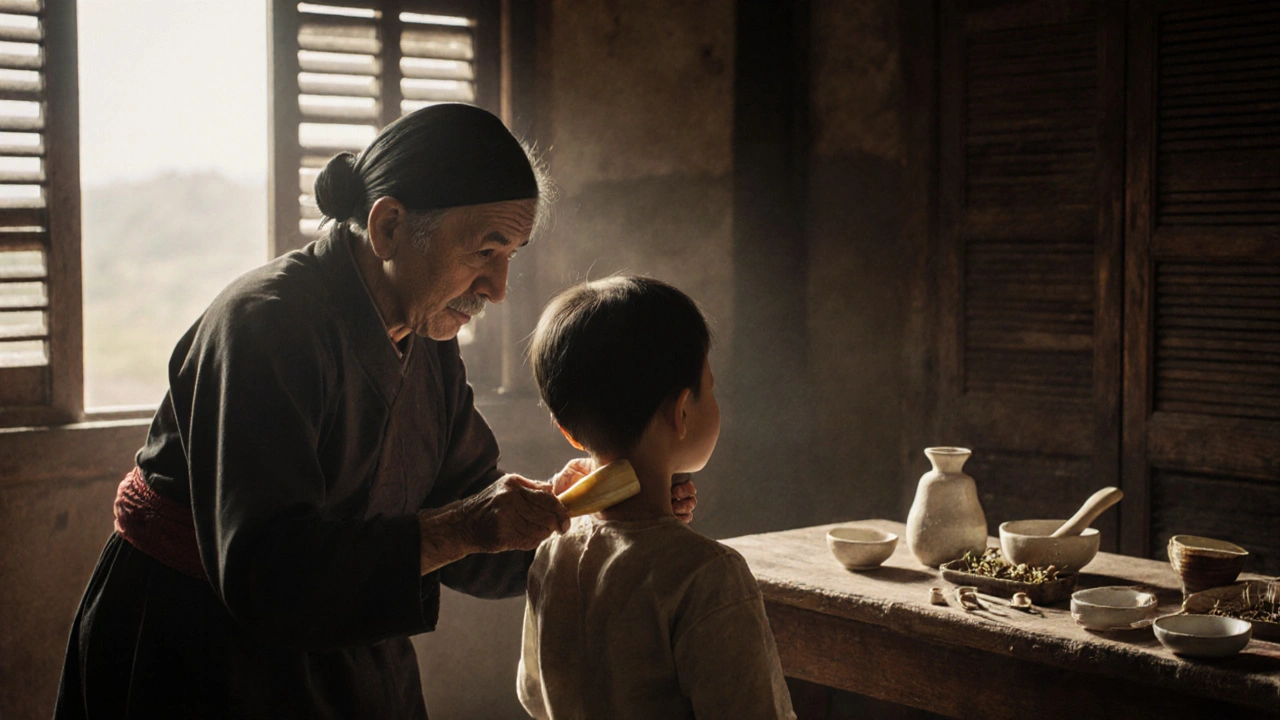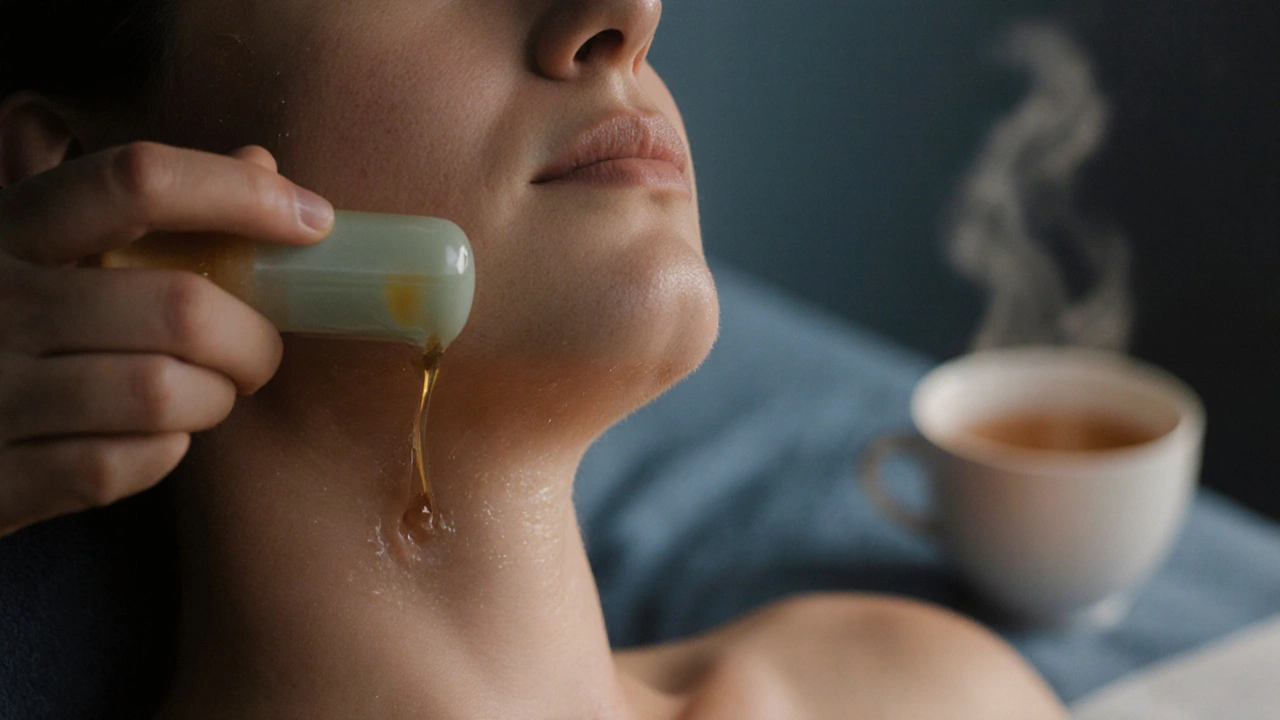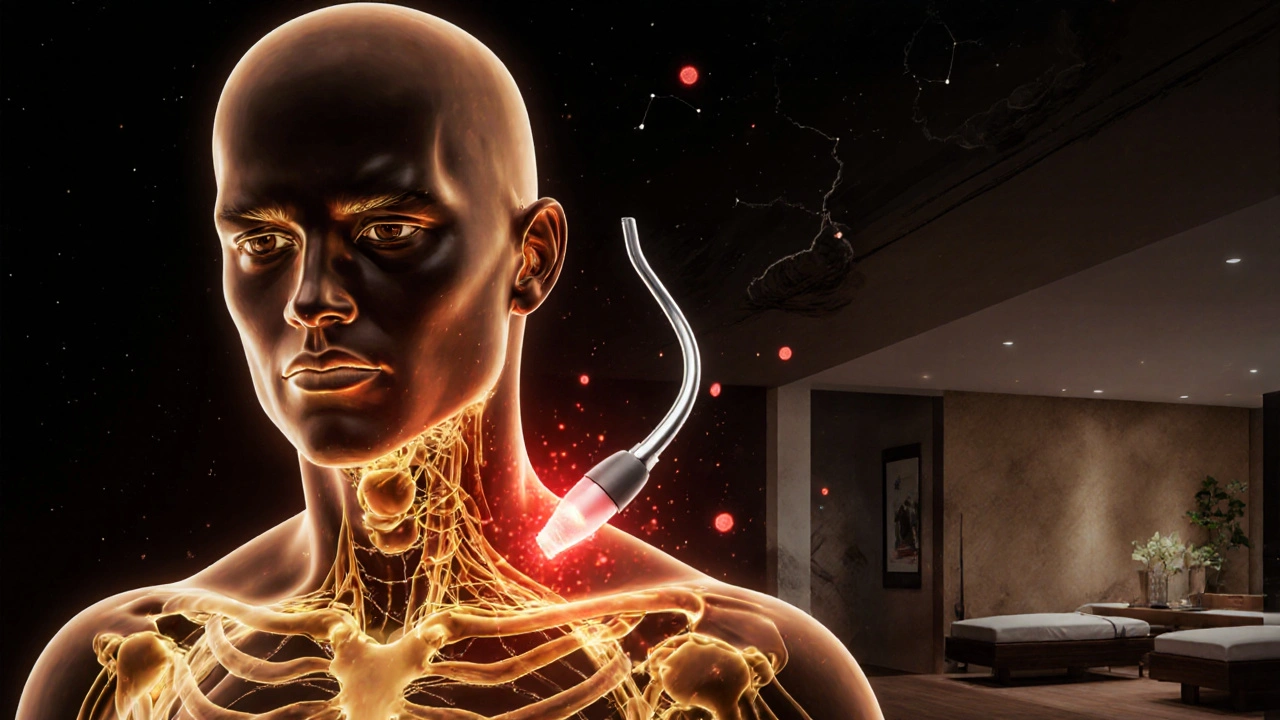Unlocking the Ancient Secrets of Gua Sha Therapy
 Nov, 15 2025
Nov, 15 2025
For thousands of years, people in China have scraped their skin with smooth stones-not to hurt, but to heal. Gua sha therapy, which literally means "scraping sand," was never meant to be a beauty trend. It was a healing tool, passed down through generations, used to move stuck energy, release tension, and bring balance to the body. Today, you see it on Instagram, in luxury spas, and on celebrity skincare routines. But the real power of gua sha lies far beyond glowing skin. It’s a quiet, ancient practice that works from the inside out.
What Gua Sha Actually Does
Gua sha isn’t just about red marks on your face or neck. Those marks-called petechiae-are not bruises. They’re tiny capillaries opening up, releasing stagnant blood and toxins that have built up over time. Think of it like unclogging a drain. When your muscles are tight, your circulation slows. Fluids pool. Energy gets stuck. Gua sha gently pushes that blockage out.
Traditional Chinese medicine sees this as moving qi-the body’s vital energy. Modern science sees it as increasing blood flow to the area by up to 400% for hours after treatment. A 2020 study in the Journal of Traditional and Complementary Medicine found that gua sha reduced inflammation markers in people with chronic neck pain within just three sessions. It’s not magic. It’s physics and physiology working together.
The Real History Behind the Practice
Gua sha didn’t start in a Seoul spa or a Beverly Hills clinic. It comes from rural China, where families used ceramic spoons, coins, or buffalo horn tools to treat fevers, colds, and muscle aches. In villages without doctors, gua sha was the go-to remedy. Grandmothers would scrape along the spine to break a fever, or down the arms to ease a cough. It was fast, cheap, and worked.
There’s no single inventor. It evolved over centuries as a folk practice, documented in texts like the Shang Han Lun from the 3rd century AD. The technique spread across Asia-Japan, Korea, Vietnam-each culture adapting it slightly. But the core idea stayed the same: pressure and motion move what’s stuck.
How Gua Sha Works on the Face
Facial gua sha isn’t new either. Ancient Chinese women used jade rollers and smooth stones to maintain skin tone and reduce puffiness. But today’s version is often misunderstood. Most people think it’s about lifting sagging skin. It’s not. It’s about lymphatic drainage.
Your face has a network of tiny lymph vessels that drain fluid and waste. When you’re stressed, sleep-deprived, or dehydrated, they slow down. That’s when you wake up with puffy eyes or a dull complexion. Gua sha gently encourages that fluid to move. It doesn’t stretch or pull skin. It helps your body do what it already knows how to do-clear out the gunk.
Real results? A 2022 clinical trial published in the Journal of Cosmetic Dermatology showed participants who did daily facial gua sha for 30 days had significantly improved skin elasticity and reduced facial edema. The glow? That’s just better circulation.

Tools You Actually Need
You don’t need a $200 jade tool to get results. The best gua sha tool is the one you’ll actually use. Traditional tools are shaped like spoons, boats, or hearts, with curved edges that follow the contours of your body.
- Jade: Cool to the touch, good for reducing inflammation and calming the skin.
- Bian Stone: A type of ancient Chinese rock, believed to emit far-infrared rays. Harder to find, but used in clinical settings.
- Buffalo horn: Warms slightly with friction, ideal for muscle tension.
- Stainless steel: Easy to clean, great for colds or sinus pressure.
For beginners, a simple, smooth-edged stone from a reputable supplier is enough. Avoid cheap plastic or glass-these can crack or have rough edges that irritate the skin. And never use a tool without oil. Gua sha isn’t dry scraping. You need lubrication-jojoba, sesame, or even a light facial oil-to let the tool glide without tugging.
How to Do Gua Sha Right
There’s only one rule: never scrape against the grain. Always follow the natural flow of your body’s energy and lymphatic pathways.
For the face:
- Apply 2-3 drops of oil to clean skin.
- Start at the center of your face-chin-and glide the tool upward along the jawline toward your ear.
- Move from the nose outward across your cheeks, stopping at the temples.
- Use the pointed end under your eyes, gently sweeping from inner to outer corner.
- On your forehead, stroke from the center out to the hairline.
- Repeat each stroke 3-5 times. No need to press hard. Let the tool do the work.
For the neck and shoulders:
- Start at the base of your skull and scrape down the sides of your neck toward your collarbone.
- Move across your shoulders, from spine to outer edge.
- Use the curved edge to follow the shape of your trapezius muscle.
Do this for 5-10 minutes, 3-4 times a week. You’ll feel looser. Your skin will look brighter. And over time, you’ll notice fewer tension headaches.

Who Should Avoid Gua Sha
Gua sha is gentle-but not for everyone. Don’t use it if you have:
- Active acne, open sores, or skin infections
- Blood thinners or clotting disorders
- Recent surgery or radiation treatment in the area
- Severe osteoporosis or fragile skin
And don’t overdo it. Daily use on the face can cause irritation. Twice a week is plenty for most people. If your skin turns purple or stays red for more than 48 hours, you’re pressing too hard. Less pressure, more patience, gives better results.
Why It Feels So Good
There’s a reason gua sha feels like a massage for your nervous system. The slow, rhythmic strokes activate the parasympathetic nervous system-the part that says, "You’re safe now."
Studies show that gentle, sustained pressure on the skin lowers cortisol levels and increases serotonin. That’s why people report feeling calmer, sleeping better, and even thinking more clearly after a session. It’s not just physical. It’s mental reset.
In Brisbane, where stress and heat pile up, many people use gua sha as their morning ritual. It’s quieter than meditation, more tactile than yoga. You hold the stone. You breathe. You move slowly. And for ten minutes, the world slows down with you.
What It Can’t Do
Gua sha won’t erase wrinkles. It won’t replace Botox. It won’t detox your liver. It won’t cure autoimmune disease. It’s not a miracle. It’s a tool-one that helps your body function better when used correctly.
Think of it like stretching. You don’t stretch once and become flexible. You stretch regularly, and over time, your body responds. Gua sha is the same. Consistency beats intensity.
The real secret? It’s not in the tool. It’s in the attention. When you take time to care for your body this way, you’re telling yourself: "I matter." That’s the oldest, most powerful part of gua sha.”
Can gua sha help with headaches?
Yes, especially tension headaches caused by tight neck and shoulder muscles. Scraping along the back of the neck and upper trapezius helps release muscle knots and improves blood flow to the head. Many people report fewer headaches after regular gua sha sessions, particularly when done daily for a week.
How long until I see results from facial gua sha?
You might notice reduced puffiness after just one session. For lasting improvements like better skin tone and elasticity, most people see changes after 2-4 weeks of consistent use (3-4 times per week). Clinical studies show measurable results at the 30-day mark.
Is gua sha safe during pregnancy?
Light facial gua sha is generally safe during pregnancy if done gently and without pressure on the neck or abdomen. Avoid deep scraping on the lower back or acupressure points linked to labor. Always check with your provider if you have high-risk conditions.
Can I use gua sha if I have rosacea?
Proceed with caution. Gua sha can increase redness in sensitive skin. If you have active rosacea flare-ups, avoid the affected areas. Use very light pressure, only on non-flushed skin, and stop if your skin stings or burns. Some people with mild rosacea benefit from gentle lymphatic drainage, but test on a small area first.
Do I need to use oil with gua sha?
Yes. Without oil, the tool will drag on your skin, causing micro-tears and irritation. Use a light facial oil, jojoba, or even coconut oil. The oil lets the tool glide smoothly and prevents friction. It also helps the skin absorb the benefits of the massage.
If you’re curious about gua sha, start small. Buy one tool. Use it three times this week. Pay attention to how your body feels-not just how your skin looks. The ancient secret isn’t in the stone. It’s in the quiet act of caring for yourself.
